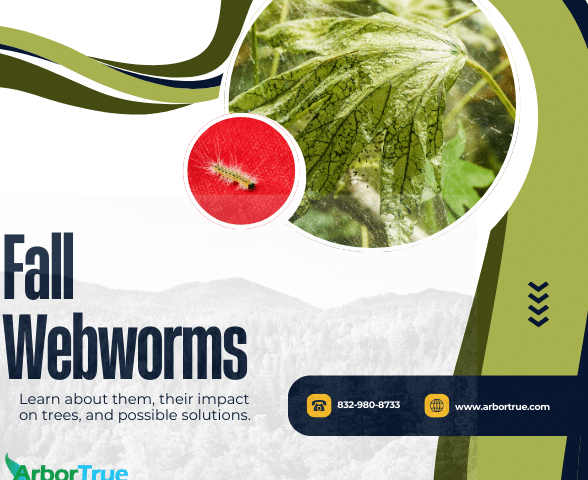
A Guest Blog Post By Field and Forest Products
June 12, 2024
One Hundred New Blog Posts
June 17, 2024
Fall Webworms: Learn About Them, Their Impact on Trees, and Possible Solutions
You’ve noticed them all around lately and maybe even seen them in the news: fall webworms. Their nests in trees can seem to pop up out of nowhere and it can be a little scary. While fall webworms can defoliate branches, their damage isn’t that bad for otherwise healthy trees. Read on to learn more about them, their impact on trees, and possible solutions.
Their Name
Fall webworms have a fairly self-explanatory common name. They look like little worms (they’re caterpillars), they make webs, and they can be seen in the fall (although depending on where you are they can start appearing in early summer or at other times). Their scientific name is Hyphantria cunea.
Their Stages
Like other insects, fall webworms go through four general stages: eggs, larvae (caterpillars), pupae, and adults. We mentioned these general stages when we looked at question mark and mourning cloak butterflies. The eggs of fall webworms are laid in groups and covered with hairs. In their larval stage, they molt as they grow. Each stage between a molt is called an instar.
What do Fall Webworm Caterpillars Look Like?
The caterpillars are green or a light yellow color with yellow spots that have black bumps, though their colors can vary greatly. They have long white hairs that come off of their bodies and get to be around one inch in length. Their heads are reddish or black. They have bumps down their backs called tubercles. Fall webworms stay as caterpillars for about six weeks. They then go to the ground where they pupate.
What Do Fall Webworm Moths Look Like?
Fall webworm moths are about one to two inches across and white (they can have spots on their wings that are black). They can also have orange coloring on their bodies and legs. Although the caterpillars chew leaves, the moths siphon liquid for nutrients.
What Damage do Fall Webworms Do?
Fall webworms damage trees by eating leaves (they leave the veins giving eaten leaves a skeletal appearance). They can consume enough that they can defoliate entire branches or even trees. Additionally, their nests can smother leaves.
Although the damage fall webworms cause can look bad (and large webs can be unsightly in trees) generally healthy trees can recover from the damage and there won’t be a lasting impact.
Why do Fall Webworms Make Webs?
Fall webworms start making webs as soon as they hatch from their eggs as caterpillars. As caterpillars they live and feed in groups using the webs for protection. As they eat more, they enlarge their webs to encompass more leaves, eventually creating webs that can be many feet across. The webs give them a place to eat protected from predators. Fall webworms will stay in their nests until after they molt for the last time. After that they will go on their own to pupate.
What Kind of Trees Do Fall Webworms Feed in?
Fall webworms feed in a number of different kinds of trees. The list is many species long. Generally, they feed in broadleaf trees and can be in a number of different trees in a landscape.
Are There any Species that Look Similar to Fall Webworms?
There are some species that can be confused for fall webworms. These include Malacosoma americanum (which makes its nests where tree limbs come together or meet the main trunk and which go out of their nests for food) and Uresiphita reversalis (they have less hairs and don’t have the same dots as fall webworms have).
What are some Solutions for Dealing with Fall Webworms?
There are some solutions for dealing with fall webworms.
The first is the simplest – just wait. Fall webworms stay as caterpillars for only around 6 weeks (though there can be more than one generation in a year) and the damage they cause generally won’t significantly impact healthy trees. Additionally, there are a number of predators for fall webworms (including lizards, wasps, and birds), and they can control the population.
The second solution is to physically destroy the webs. This can be done with a stick or with water from a hose. In some cases you might prune out branches with large webs. Opening webs up can allow predators to get at the caterpillars.
A third solution is to use an insecticide. These can work better when the webs are first made as the insecticide can work better on small caterpillars and the webs can be protection against liquid insecticides. One type of insecticide is one that contains Bt (Bacillus thuringiensis). If you are considering insecticide as a solution, contact a trained professional so that it can be applied appropriately.
If you are having an issue with fall webworms, reach out to us. Our arborists can assess your situation and let you know what solution might be best for you.
If you found this information about helpful, check out our other posts on our TrueTreeTalk blog. Follow us on Facebook to keep up with these and other posts. Check out our list of blog posts grouped by topic for more to read. Also, follow us on LinkedIn for industry-related posts.
* * *
ArborTrue is a science-based tree service company in the greater Houston area. We also serve Austin and other parts of Central Texas. We provide a range of services including tree trimming, tree pruning, tree removal, tree planting, arborist consultations, and more. Call us today at 832-980-8733 (Houston) or at 512-546-3833 (Austin) or reach out to us online to schedule an appointment.
ArborTrue has a dedicated landscaping division, now serving select areas in the greater Houston region—with more locations coming soon. We specialize in organic practices, soil biology, and ecological health to help your entire landscape truly thrive. To learn more or schedule a consultation, contact us at landscape@arbortrue.com.




